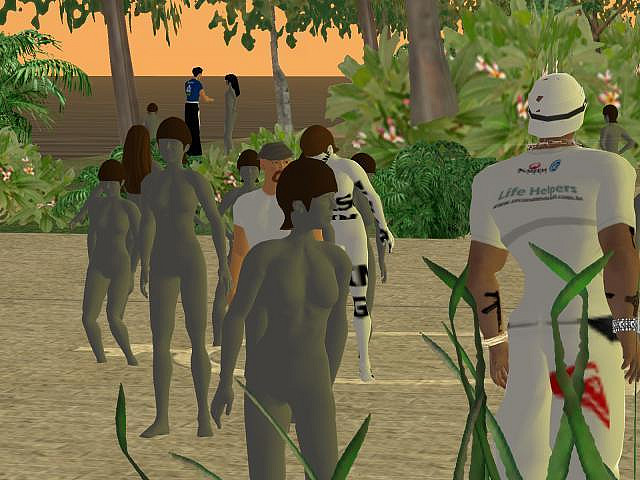Online Identities and Ambivalence

ambiguity is a feature of online identity.. amorphous half-rezzed newbies look to a "Life Helper" for guidance
Composition scholars have previously noted the benefits of Second Life over MMORPGs in establishing critical awareness of online identities—again, recalling that phronesis, who we are, is central to the creation of those online selves. And those online selves serve as a remediation (Bolter and Grusin) of the selves we represent in other facets of life, both online and offline. In Second Life, as in other earlier virtual worlds such as MOOs and MUDs, players are the writers of their online selves, and the choices they make connect to their offline selves. Reflection on those connections can be quite enlightening.
Jennifer DeWinter and Stephanie Vie chose Second Life as the focus of their 2008 article “Press Enter to ‘Say’: Using Second Life to Teach Critical Media Literacy” because it is not a closed system, but a complex, ambivalent, and contagioned one “commercialized by major corporations, populated by volunteer players, and immersed in hegemonic power structures” (314); also, they were attracted to the fact that many academic institutions already had established a presence there. They distinguish Second Life from MMORPGs such as World of Warcraft and Everquest because it “allows users to define their own goals through play” (315). All of these factors led the authors to explore Second Life as a vehicle for foregrounding the critical apprehension of the formation of subjectivity and, in particular, of online identities. They note:
To develop critical media literacies…students need to understand the post-human subjectivities that they create and leave behind in the memory of computerized environments…Many students do not recognize the breadth of their online audience; they also are often unaware of the ways their personal information contained online may be used without their consent. Thus, conversations about subjectivity need to include the many writerly spaces that students simultaneously occupy, especially online, with an eye toward increasing students’ understanding of how issues of privacy, intellectual property, and other once-embodied concerns have shifted as a result of increased participation in computerized environments. (316)
DeWinter and Vie discuss the presence of harassment, racism, and other social contagions in Second Life as something that instructors cannot entirely protect students from; even if one creates a “safe space” for students to dwell during class activities, they will run across adult areas and activities if they explore the world with any thoroughness. They suggest that encountering such phenomena should generate teachable moments: “While instructors should be concerned about what happens in Second Life, these experiences allow us to talk with students about hegemonic power structures that often go unnoticed, invisible, in their first lives” (319). They conclude, “Spaces like Second Life are not innocent, neutral tools. They are imbricated in systems of power that affect access, interaction, and corporate interest” (320). These realities are never more apparent than in the earlier example of Vassar Campus’ Sistine Chapel exhibit and the inappropriate sexual behavior of avatars in the exhibit. From the college’s perspective, the visitors were engaging in offensive and inappropriate behavior, as they were expected to be aware of the class and cultural values embedded in the very idea of the Sistine Chapel and Vassar; from the visitors’ perspective, it might have seemed that they were the ones being harassed and prevented from freedom of expression in a play or gamelike space that they were paying for access. Such an incident demonstrates quite vividly the inability of schools to create an unambivalent space free of troubling distractions without losing touch with the larger world of potential learners they wish to reach.
